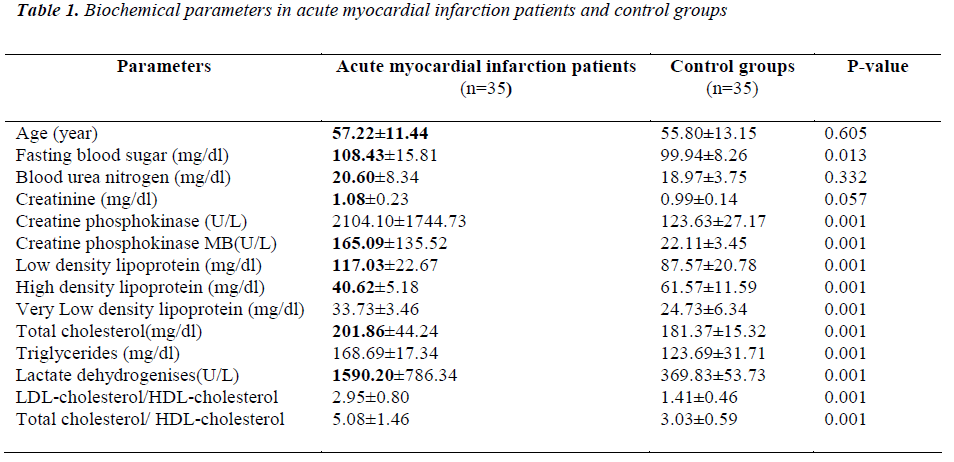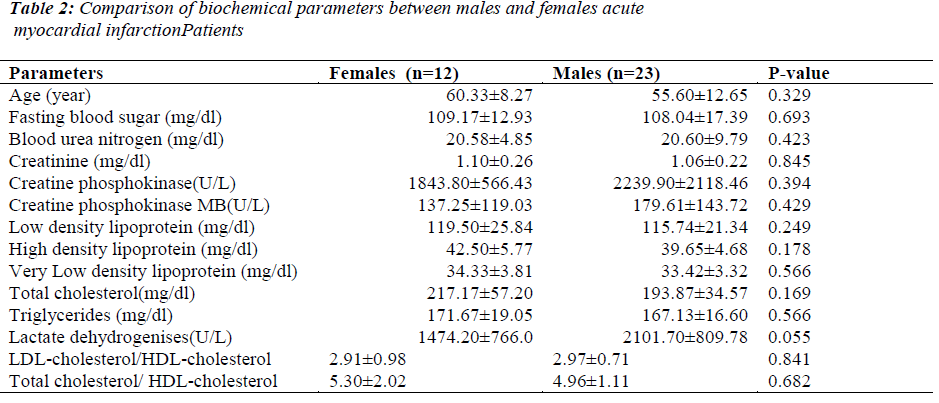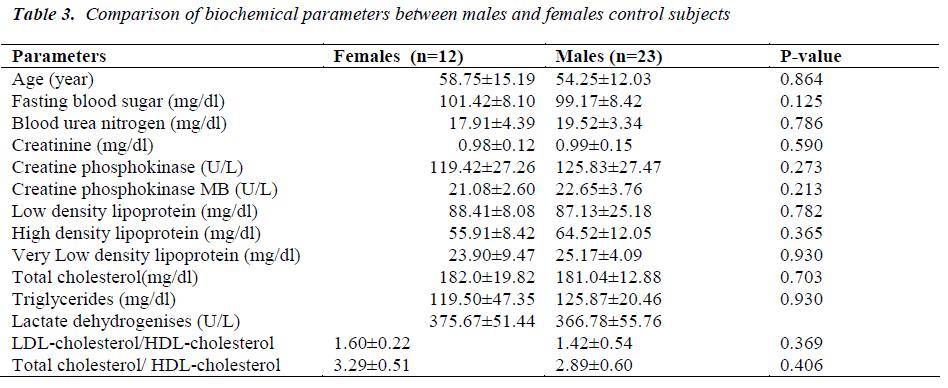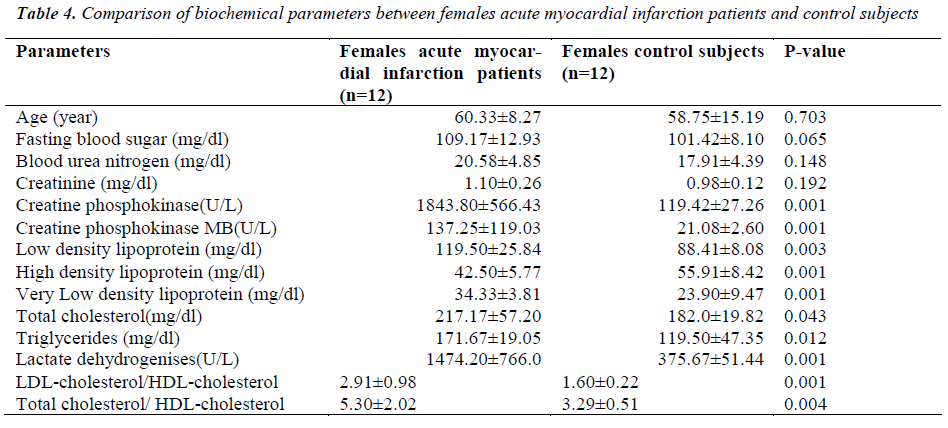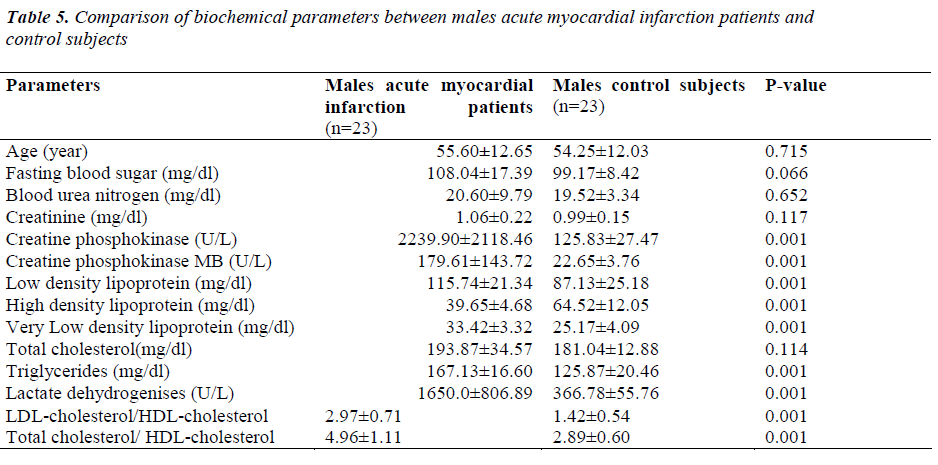ISSN: 0970-938X (Print) | 0976-1683 (Electronic)
Biomedical Research
An International Journal of Medical Sciences
- Biomedical Research (2012) Volume 23, Issue 1
Serum lipid profiles in acute myocardial infarction patients in Gorgan
Ahmad Shirafkan1, Abdoljalal Marjani2* and Farhad Zaker3
1Department of Cardiology, Gorgan Faculty of Medicine, Golestan University of Medical Sciences. Gorgan, Iran
2Department of Biochemistry and Biophysics, Biochemistry and Metabolic Disorder Research Center, Gorgan Faculty of Medicine, Golestan University of Medical Sciences, Gorgan, Iran
3Department of Cardiology, Gorgan Faculty of Medicine, Golestan University of Medical Sciences. Gorgan, Iran
- Corresponding Author:
- Abdoljalal Marjani
Gorgan Faculty of Medicine Department of Biochemistry and Biophysics Gorgan Faculty of Medicine Golestan University of Medical Sciences Gorgan, Golestan Province, .Iran.
Accepted date: July 7 2011
Acute myocardial infarction is one of the important reasons of death and unhealthiness in the world. The present study was undertaken to investigate the changes in serum lipids and lipoproteins in patients with acute myocardial infarction. This study was performed in the Biochemistry and Metabolic Disorder Research Center of Gorgan, Golestan province (South East of Caspian Sea), Iran in 2011.The levels of lipid profile were significantly changed in the acute myocardial infarction patients. acute myocardial infarction patients had significantly higher levels of total cholesterol, LDL-cholesterol, VLDLcholesterol, TG, LDL-cholesterol /HDL-cholesterol, total cholesterol /HDL-cholesterol, LDH, CPK and CPK-MB and lower level of HDL-cholesterol, as compared to the control subjects. We found a significant association of lipid profiles with acute myocardial infarction. Changing of dietary and social activity habits of people in this area can help to prevent future atherogenic damaging in AMI patients. Changing of dietary and social activity habits of people in this area can help to prevent future atherogenic damaging in AMI patients. Reduced serum HDL-cholesterol in our study subjects may be one of the effective reasonable lipid disorders in AMI patients.
Keywords
lipid profiles, acute myocardial infarction, Gorgan
Introduction
Acute myocardial infarction is one of the important reasons of death and unhealthiness in the world. Various risk factors for coronary heart disease have been reported, including age, gender, race and family history and an another risk factors, like serum cholesterol, smoking, diabetes and high blood pressure can be changed [1]. Myocardial Infarction (MI) comes together as a results of environmental causes and personal susceptibilities [2-5]. In the United States and United Kingdom, nearly 650,000 and 180000 patients get an acute myocardial infarction (AMI) every year, respectively [6]. According to WHO planned in the year 2005 that the coronary heart disease causes for 7.6 million deaths (13.2% of total deaths) whole world. Above 80% of these deaths took place in fewer developing countries [7]. In our country, Iran, rate of death because of cardiovascular disease comprised 26.6% and 47.3% of deaths in the years 1987 and 1995, respectively [8]. Acute myocardial infarction accounts for a very many of deaths in Iran [9]. There are several assessments on the variations of serum lipid profiles following myocardial infarction. Many researchers have reported a decrease in total cholesterol [10-19], HDLcholesterol [18] and LDL-cholesterol [16-18] after acute myocardial infarction. In another studies showed that there is no modification in serum total cholesterol [20],
HDL-cholesterol [16, 20] and triglycerides levels [13,20-23]. Various studies have shown that the total cholesterol to HDL cholesterol and of LDL cholesterol to HDL cholesterol ratios can be used as predictors of acute coronary occurrences [24-25]. The present study was undertaken to investigate the changes in serum lipids and lipoproteins in Patients with acute myocardial infarction in Gorgan (South East of Caspian Sea), Iran.
Materials and Methods
This study was performed in the Biochemistry and Metabolic Disorder Research Center of Gorgan, Golestan province (South East of Caspian Sea), Iran in 2011. The study group included 35 subjects (12 females and 23 males) with acute myocardial infarction (with the mean age of 57.22±11.44 years old) who were referred to the intensive Coronary Care Unit in 5th Azar Hospital ( the only general teaching hospital in Gorgan), Gorgan Faculty of Medicine, Golestan University of Medical Sciences. None of the patients had thyroid dysfunction, diabetes, hypertension and liver or kidney disease. All the included subjects provided an informed consent. We also chosen 35 healthy subjects (12 females and 23 males with the mean age of 55.80±13.15 years old) as our control group and matched them for age and gender. The exclusion criterion was the coexistence of any other serious illness. A venous blood sample was collected from all the subjects after 12-hours overnight fast. The samples were centrifuged for 10 minutes at 3000 rpm. Fasting levels of serum blood glucose, total cholesterol, High Density Lipoprotein (HDL) cholesterol, Low Density Lipoprotein cholesterol (LDL) Very Low Density Lipoprotein cholesterol (VLDL), Triglycerides (TG), lactate dehydrogenase (LDH) and Creatine Phospho Kinase (CPK) and Creatine Phospho Kinase-MB (CPK-MB) levels were measured by enzymatic methods using spectrophotometer techniques (Model JENWAY 6105 UV / VIS) in the Biochemistry and Metabolic Disorder Research Center (Faculty of Medicine). Acute myocardial infarction was defined as prolonged chest pain and was diagnosed as acute myocardial infarction on clinical examination, electrocardiographic changes and laboratory basis. The results were reported as mean ± SD. The statistical analysis was done with SPSS- 11.5 version software. The results were evaluated by using student't' test to determine the significance of biochemical parameters among two groups. Statistical significance was considered at P < 0.05.
Results
The clinical characteristics of acute myocardial infarction patients and control subjects have been shown in tables 1, 2, 3, 4 and 5. A number of obvious differences between two subjects are found. Table 1 shows that acute myocardial infarction patients had higher levels of total cholesterol, LDL-cholesterol, VLDL-cholesterol, TG, LDLcholesterol /HDL-cholesterol, total cholesterol /HDLcholesterol, LDH, CPK and CPK-MB and lower level of HDL-cholesterol, as compared to the control subjects. Notably, all above mentioned biochemical parameters (HDL-cholesterol was significantly lower) were significantly higher in acute myocardial infarction patients than in control subjects (P< 0.05) (Table 1).Table 2 shows comparison of biochemical parameters between males and females acute myocardial infarction patients. The data shown in Table 2 reveals that there was no significant difference in all parameters in female and male patients. Table 3 shows comparison of biochemical parameters between males and females control groups. There was no significant difference in all parameters in both genders. The data of Table 4 shows that female acute myocardial infarction patients had significantly higher levels of total cholesterol, LDL-cholesterol, VLDL-cholesterol, TG, LDL-cholesterol /HDL-cholesterol, total cholesterol /HDL-cholesterol LDH, CPK and CPK-MB and significantly lower level of HDL-cholesterol, as compared to female control subjects (P< 0.05). The data of Table 5 shows that male acute myocardial infarction patients had significantly higher levels of in table 4 mentioned biochemical parameters when compared with male control subjects (P< 0.05). But this is not the same for total cholesterol in male acute myocardial infarction patients when compared with male control subjects
Discussion
Coronary heart diseases are the most important factor of death [26]. There is an increasing prevalence of these diseases in developing countries [7]. Study of Bitla et al [27] showed that Patients with MI showed no significant change in lipid profile when compared to healthy controls. Ryder et al. [28] reported that there is no significant alteration in triglyceride levels. Study of Vetter et al. [29] showed that triglyceride levels diminished slowly from the second hour after myocardial infarction. Some studies showed that there are correlations between the occurrence of AMI and abnormality of lipid profiles [30]. Some other study showed that there was an increase in serum triglycerides during AMI [31,32]. Study of Salahuddin et al. revealed significantly high levels of triglycerides and low levels of HDL-cholesterol in AMI patients compared to control subjects [32]. In our present study, serum triglyceride levels showed significant increase in AMI patients when compared with control subjects. According to the present study, this result was in agreement with our finding. There is a different mechanism about elevation of triglycerides after MI. It is reported that elevated triglyceride levels may depend on genetic basis [33] and nutritional habits [34]. Triglyceride levels may change because of inherited abnormality of very low density lipoprotein It may be happen because of increased flowing of fatty acids and impaired elimination of VLDL from the plasma [35].We found significant change in serum total cholesterol levels after acute myocardial infarction. Our study is in agreement and in contrast to that by other researchers who found either an increase [36,12] or a decrease [37-39,28,40] or normal cholesterol [30,41] during the acute myocardial infarction. This shows that serum cholesterol level reveal no differences between persons with and without AMI. Elevated serum cholesterol has depended on elevated consumptions of fat [42] and genetic basis [33]. LDL carries the most of cholesterol in the plasma and increasing of LDL depend on increasing of total cholesterol level [43]. Reduction of HDLc concentration in our findings is not in agreement with the other studies that shown either a increase [40] or no change [41] and in agreement with the other study [32]. Several studies have supported that the ratios of LDL-cholesterol /HDL-cholesterol and total cholesterol /HDL-cholesterol show the atherosclerotic injury of the wall of the vessels [44-46]. We found significant increase in ratios of LDLcholesterol /HDL-cholesterol and total cholesterol /HDLcholesterol levels after acute myocardial infarction. The latest studies in agreement with our studies. Study of Some studies have shown that there is a significant decrease in LDL-cholesterol following MI [47,28]. Sandkamp et. al. (48) showed that LDL-Ch level increased and this is in agreement with our finding. LDL-Ch level may be increase as a result of reducing in refining or excessive production of LDL-Ch [49]. LDL cell surface receptors cleaned LDL-Ch from the circulation. These receptors may change as a result of coronary heart disease, thus uptake of LDL-Ch is decreased [50]. On the other hand, increasing of LDL possibly as a result of excessive production of VLDL and /or decreasing of VLDL remnants (Low activity of LDL receptors)[51]. The results of our study shows significant increase in total cholesterol, LDL-cholesterol, VLDL-cholesterol, TG, LDLcholesterol /HDL-cholesterol and total cholesterol /HDLcholesterol after acute myocardial infarction. Thus, we found a significant association of lipid profiles with acute myocardial infarction. Changing of dietary and social activity habits of people in this area can help to prevent future atherogenic damaging in AMI patients. Reduced se rum HDL-cholesterol in our study subjects may be one of the effective reasonable lipid disorders in AMI patients.
Acknowledgement
The authors would like to thank the personnel at the Biochemistry and Metabolic Research Center and cardiology center of Golestan University of Medical Sciences for providing for their cooperation and assistance in the handling of experiments.
References
- Camm AJ. Cardiovascular disease. In: Kumar P, Clark M. Clinical Medicine. 5th ed. London: Bath Press, 2002: 766-783.
- Ahmed IA. Myocardial-infraction based on intelligent techniques. Am J Applied Sci 2010; 7: 349-351.
- Dehlaghi V, Najarian S, Shadpour MT. Effect of stent geometry on phase shift between pressure and flow waveforms in stented human coronary artery. Am J Applied Sci 2008; 5: 340-346.
- Jahromi AS, Shojaie M, Dana S, Madani A. Anticardiolipin antibody in acute myocardial infarction. Am J Immunol 2010; 6: 11-14.
- Zimmerman FH, A. Cameron LD, Ng G. Myocardial infarction in young adults: Angiographic characterization, risk factors and prognosis (coronary artery surgery study registry). J Am Coll Cardiol 1995; 26: 654-661.
- Braunwald E. Approach to the patient with cardiovascular disease. In: Kasper DL, Braunwald E, Fauci AS, Hauser SL, Longo DL, Jameson JL. Harrison’s Principles of Internal Medicine; 16th ed. New York: McGraw-Hill, 2005; 1301-1494.
- World Health Organization. The World Health Report: reducing risks, promoting healthy life [Online]. 2002; Available from: URL: http://www.who.int/whr/2002/- en.
- Sarrafzadegan N, Boshtam M, Malekafzali H, Bashardoost N, Sayedtabatabaei FA, Rafiei M, et al. Secular trends in cardiovascular mortality in Iran, with special reference to Isfahan. Acta Cardiol 1999; 54 (6): 327- 333.
- Azizi F, Hatami H, Janghorbani M. Epidemiology of Common Diseases in Iran. 2nd ed. Tehran Didavar Company, 2001; pp. 10-22.
- Biorch, G., Blomquist, G. and Sievers, J. Cholesterol values in patients with myocardial infarction and normal control group. Acta Med Scand 1957; 156: 493- 497.
- Bjorntrop P, Malmcrone R. Serum cholesterol in patient with myocardial infarction in younger ages. Acta Med Scand 1960; 168: 151-155.
- Dodds, C. and Mills, G.L. Influence of myocardial infarction on plasma lipoprotein concentration. Lancet. 1959; 1160 -1163.
- Tibblin G, Cramer K. Serum lipids during the course of acute myocardial infarction and one year afterwards Acta Med Scand 1963; 174, 451-455.
- Fyfe T, Baxter RH, Cochran KM, Booth EM. Plasma lipid changes’after myocardial infarction. Lancet. 1971; 997-1001.
- Kirkeby K. Disturbances in serum lipids and in their fatty’ acid composition following acute myocardial infarction. Acta Med Scand 1972; 192: 523-528.
- Avogaro A, Bittilin Bon G, Cazzalato C, Quinci GB, Sanson A, Sparla H, Zagatti GC. Variations in apolipoproteins B and A during the course of myocardial infarction. Eur. J. Clin. Invest. 1978; 8; 121-129.
- Ballantyne FC, Melville DA, Mc Kenna JP, Morrison BA, Ballantyne D. Response of plasma lipoproteins and acute phase proteins to myocardial infarction. Clin Chim Acta 1979; 99: 85-92.
- Ryder REJ, Hayes TM, Mulligan IP, Kingswood JC, Williams S, Owens DR. How soon after myocardial infarction should plasma lipid values be assessed? Br Med J 1984; 289: 1651-1653..
- Jackson, R., Scragg, R., Marshall, R, White, O’Brien, K. and Small, C. Changes is serum lipid concentrations during first 24, hours after myocardial infarction. Br. Med. J. 1987; 294, 1588-1589.
- Heldenburg, D., Rubenstein, A., Levtov, 0., Berns, L., Werbin, B. and Tamir, L. Serum lipids and lipoprotein concentrations during the acute phase of myocardial infarction. Atherosclerosis. 1980; 35,433-437.
- Fredrickson, D.S. The role of lipids in acute myocardial infarction. Circulation. 1969; 39, Suppl. IV-99-IV-III.
- Swedarsen, M., Vythilingum, S., Jialal, I. and Nadar, R. Plasma lipids can be reliably assessed within 24 hours after acute myocardial infarction. Postgrad. Med. J. 1988; 64, 352-356.
- Castelli WP. Epidemiology of coronary heart disease: the Framingham Study. Am J Med 1984; 27: 4–12.
- Linn S, Fulwood R, Carroll M, et al. Serum total cholesterol: HDL cholesterol ratios in US white and black adults by selected demographic and socioeconomic variables (HANES II). Am J Public Health 1991; 81: 1038-1043.
- Jialal I, Devaraj S. Low density lipoprotein oxidation, antioxidants and atherosclerosis. Clin Chem. 1996; 42: 498-506.
- Bitla AR, Pallavi M, Vanaja V, Suchitra MM, Reddy Seshadri V, Prabhakar Reddy E, Srinivasa Rao P.V.L.N. Acute Myocardial Infarction in a Southeast Indian Population: Comparison of Traditional and Novel Cardiovascular Risk Factors Research Journal of Medicine and Medical Sciences. 2009; 4(2): 202-206.
- Ryder REJ, Hayes TM, Mulligan IP, Kingswood JC, Williams S, Owens DR. How soon after myocardial infarction should plasma lipid values be assessed? Br Med J 1984; 289; 1651-1653.
- Vetter NJ, Adams W, Strange RC, Oliver MF. Initial metabolic and hormonal response to acute myocardial infarction. Lancet 1974; 284-289.29.
- Berlin R, Oldfelt CO, Vikrot O. Acute myocardial infraction and plasma phospholipids levels. Acta Med. Scand. 1969; 185, 439-442.
- Pocock SJ, Shaper AG, Philips AN, Walker M, Whitehead TP. High density lipoprotein cholesterol is not a major risk factor for ischemic heart disease. British Medical Journal. 1986; 292: 515-519.
- Salahuddin, Karira KA, Shah SMA, et al. Serum homocysteine in patients with acute myocardial infarction. Pakistan J Cardiol. 2000; 11: 93-99..
- Goldstein JL, Hazzard WR, Schrott HG : Hyperlipidemia in coronary heart disease. J Clin Invest. 1973; 52: 1533-1543.
- Watts GF, Jackson P, Mandalia S. Nutrient intake and progression of coronary artery disease. Am J Cardiol. 1994; 73: 328-332.
- Fredrickson DS. The role of lipids in acute myocardial infarction. Circulation. 1969; 39,Suppl. IV-99-IV-III
- Dyerberg J, Bang, H.O. and Neilsen, J.A. Plasma lipids and lipoproteins in patients with myocardial infarction and in a control material. Acta Med. Scand. 1970; 187, 353-359.
- Bjorntrop P, Malmcrone R. Serum cholesterol in patient with myocardial infarction in younger ages. Acta. Med. Scand. 1960; 168, 151-155.
- Tibblin G, Cramer K. Serum lipids during the course of acute myocardial infarction and one year afterwards Acta Med. Scand. 1963; 174, 451-455.
- Kirkeby K. Disturbances in serum lipids and in their fatty’ acid composition following acute myocardial infarction. Acta Med Scand 1972;192, 523-528.
- Jackson R, Scragg R, Marshall R, White O’Brien K, Small C. Changes in serum lipid concentrations during first 24, hours after myocardial infarction. Br. Med. J. 1987; 294, 1588-1589.
- Heldenburg D, Rubenstein A, Levtov 0, Berns L, Werbin B, Tamir L. Serum lipids and lipoprotein concentrations during the acute phase of myocardial infarction. Atherosclerosis.1980; 35: 433-437.
- Garcia RM, Sorlie P, Costas R. Relationship of dietary intake to subsequent coronary heart disease incidence. American Journal of Clinical Nutrition 1980; 33:1818.
- Hargreaves AD, Logan RL and Thomson M: Total cholesterol, LDL-Ch and HDL-Ch and coronary heart disease BMJ 1991; 303:678.
- Natio HK. The association of serumlipids, lipoproteins and apolipoproteins with coronary artery disease assessed by coronary arteriography. Ann. N.Y. Acad. Sci. 1985; 454, 230-238.
- Zampogna A, Luria MH, Mancibens SJ, Luria MA. Relationship between lipids and occlusive coronary disease. Arch. Intern Med 1980; 140, 1067-1069.
- Luria MH, Erel J, Sapoznikov D, Gotsman MS. Cardiovascular risk factor clustering and ratio of total cholesterol to high-density lipoprotein cholesterol in angiographically documented coronary artery disease. Am. J. Cardiol. 1991; 67, 31-36.
- Ballantyne FC, Melville DA, Mc Kenna JP, Morrison BA, Ballantyne D. Response of plasma lipoproteins and acute phase proteins to myocardial infarction. Clin. Chim Acta 1979; 99, 85-92.
- Sandkamp M, Funke H and Schulte H : Lipoprotein (a) is an independent risk factor for myocardial infarction. Clin Chem 1990; 36: 20-23.
- Grundy SM, Vega GL, Kesaniemi YA. Abnormalities in metabolism of LDL associated with coronary heart disease. Acta Medica Scand 1985; 701: 23-37.
- Ball M and Mann JJ: Apoproteins: predictors of coronary heart disease? Br Med J 1986; 27: 769- 770.
- Kromhout D: Body weight, diet and serum cholesterol in middle aged men during 10 years follow up. Am J Clin Nutr. 1983; 38: 591-598.
